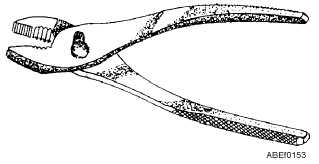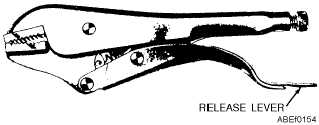The combination pliers are handy for holding or
bending flat or round stock. The long-nosed pliers are
less rugged, and break easily if you use them on heavy
jobs. Long-nosed pliers, commonly called needle-nose
pliers, are especially useful for holding small objects in
tight places and for making delicate adjustments. The
round-nosed kind are handy when you need to crimp
sheet metal or form a loop in a wire. The diagonal
cutting pliers, commonly called "diagonals" or "dikes,"
are designed for cutting wire and cotter pins close to a
flat surface and are especially useful in the electronic
and electrical fields. The duckbill pliers are used
extensively in aviation areas.
Here are two important rules for using pliers:
1.
Do not make pliers work beyond their capacity.
The long-nosed kind is especially delicate. It is
easy to spring or break them, or nick their
edges. After that, they are practically useless.
2.
Do not use pliers to turn nuts. In just a few
seconds, a pair of pliers can damage a nut.
Pliers must not be substituted for wrenches.
SLIP-JOINT PLIERS
Slip-joint pliers (fig. 1-43) are pliers with straight,
serrated (grooved) jaws, and pivot where the jaws are
fastened together to move to either of two positions to
grasp small- or large-sized objects better.
Slip-joint combination pliers are pliers similar to
the slip-joint pliers just described but with the
additional feature of a side cutter at the junction of the
jaws. This cutter consists of a pair of square-cut
notches, one on each jaw, which act like a pair of shears
when an object is placed between them and the jaws
closed.
WRENCH PLIERS
Wrench pliers (visegrips) (fig. 1-44), can be used
for holding objects regardless of their shape. A screw
adjustment in one of the handles makes them suitable
for several different sizes. The jaws of wrench pliers
may have standard serrations such as the pliers just
described, or they may have a clamp-type jaw. The
clamp-type jaws are generally wide and smooth and are
used primarily when working with sheet metal.
Wrench pliers have an advantage over other types
of pliers in that you can clamp them on an object and
they will stay. This will leave your hands free for other
work.
A craftsman uses this tool a number of ways. It may
be used as a clamp, speed wrench, portable vise, and for
many other uses where a locking, plier-type jaw may be
used. These pliers can be adjusted to various jaw
openings by turning the knurled, adjusting screw at the
end of the handle (fig. 1-44). Wrench pliers can be
clamped and locked in position by pulling the lever
toward the handle.
CAUTION
Wrench pliers should be used with care,
since the teeth in the jaws tend to damage the
object on which they are clamped. They should
not be used on nuts, bolts, tube fittings, or other
objects that must be reused.
WATER-PUMP PLIERS
Water-pump pliers were originally designed for
tightening or removing water-pump packing nuts. They
were excellent for this job because they have a jaw
adjustable to seven different positions. Water-pump
pliers (fig. 1-45) are easily identified by their size, jaw
teeth, and adjustable slip joint. The inner surface of the
jaws consists of a series of coarse teeth formed by deep
1-28
Figure 1-43.—Slip-joint pliers.
Figure 1-44.—Wrench pliers.
Figure 1-45.—Water-pump pliers.





